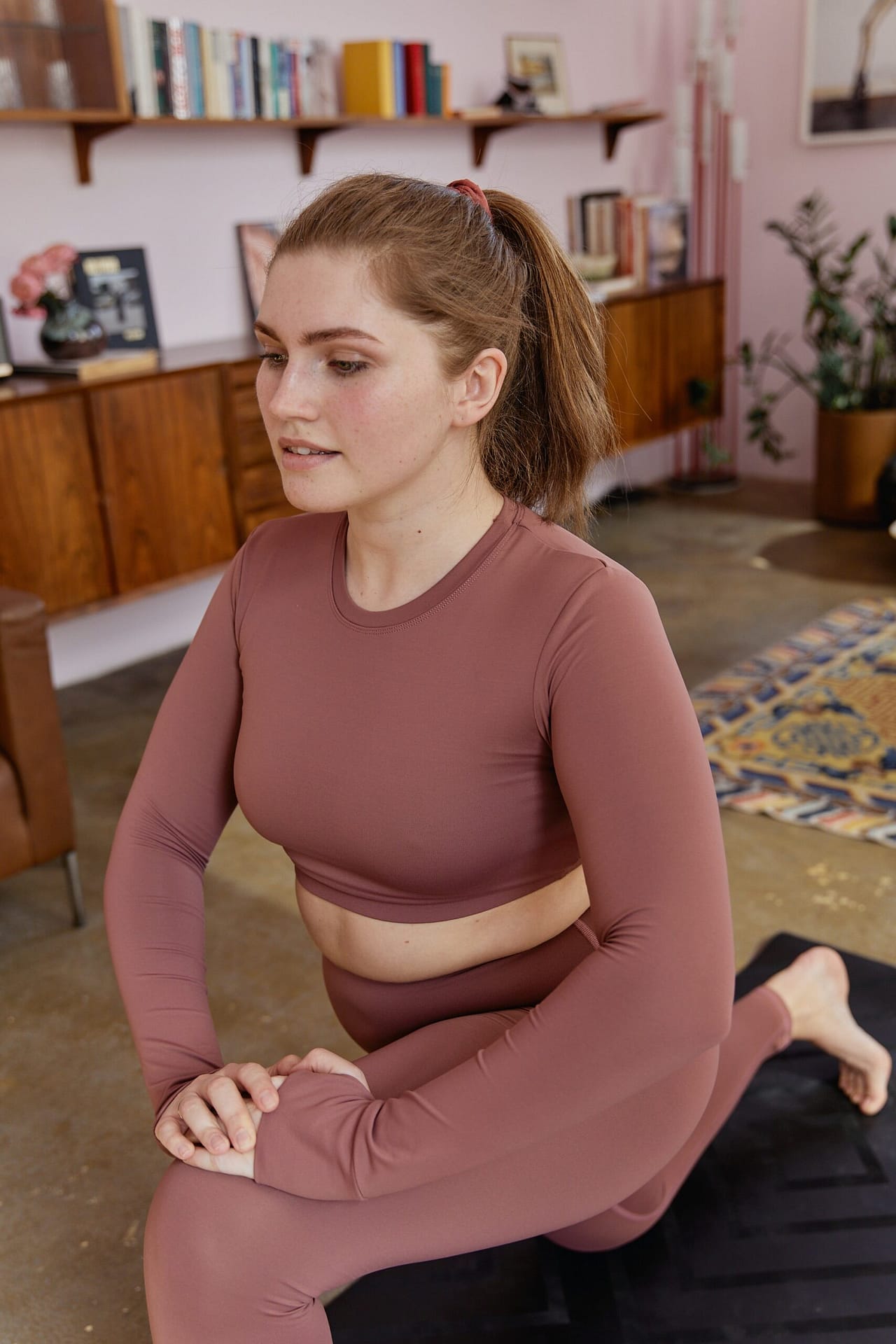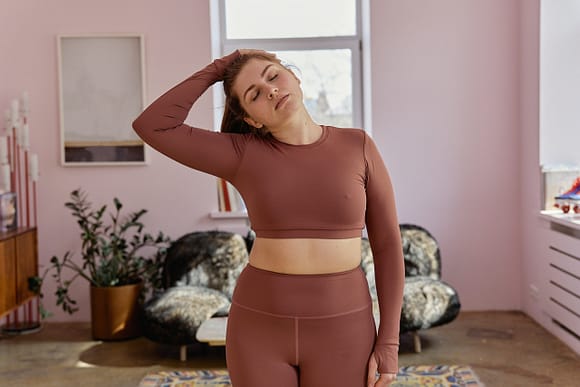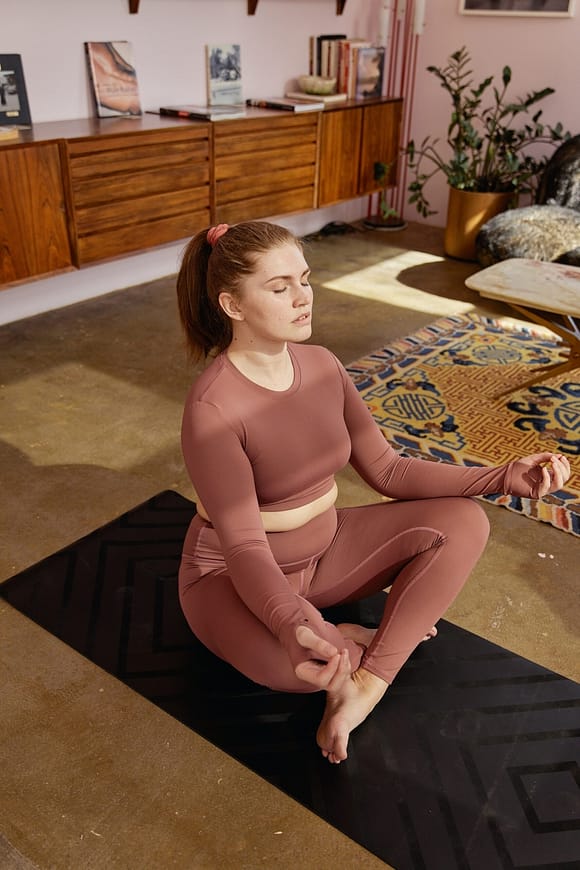When you have Fibromyalgia, doing pretty much anything hurts or is ungodly tiresome.
Case in point: your symptoms make you foggy-brained, stiff as a board, and ready to hit the hay when it’s only 9 AM (hi, it takes one to know one).
That’s because Fibromyalgia is a chronic condition that causes widespread pain, tenderness, and stiffness throughout the body.
While there is no cure for Fibromyalgia, stretching can help manage your pain, increase flexibility, and improve fatigue.
Here are 13 of the best stretches for Fibromyalgia (FM) to do in the morning, afternoon, and evening.
In addition, I’ll explain why yoga can be so beneficial for those who have FM.
What’s the best exercise for Fibromyalgia?
It’s generally recommended that the best exercise for Fibromyalgia patients is low-impact, such as bicycling, swimming, walking, bodyweight exercises, and, yep – yoga.
This is because low-impact exercises strengthen your body’s ability to carry itself and move.
Low-impact movements like stretching and yoga also help fight fatigue.
The hard part for many of us is that with Fibro, it’s often difficult to motivate yourself and feel good enough to exercise. Plus, exercise often worsens the pain.
Much worse than the average Joe without Fibro feels after working out.
They feel sore; you feel dead as a doorknob for days.
Maybe even weeks, if it’s that kind of season.
Therefore, start slowly with an exercise routine to minimize any help-I’ve-been-smacked-by-a-truck-feels.
Does yoga help Fibromyalgia pain?
Several studies support yoga’s effectiveness in reducing Fibromyalgia pain, fatigue, and even depression. In fact, yoga is one of the most commonly “prescribed” exercise regimens for people living with Fibromyalgia.
For example, in 2010, the Oregon Health and Science University found that yoga was beneficial in reducing Fibro symptoms.
In 2015, a study found that at-home yoga and in-person classes were both effective in relieving symptoms – so don’t think a little time at home won’t help, because it will!
Furthermore, patients significantly improved their health-related quality of life score when they practiced yoga, per a 2016 study from the University of Toronto.
So yes, evidence supports yoga’s effectiveness at improving Fibromyalgia pain and life quality.
13 best stretches for Fibromyalgia
This is not an exhaustive list, but these are poses that I practice almost every day because I love how stretched out they make my body feel. These poses are also proven to help ease pain, discomfort, and stress.
With Fibromyalgia, my body, especially my legs, feel like they’re in cement and want to stretch out (they are yearning to stretch out forever like bendy appendages), and while they don’t always magically take away the pain, they do help relax my muscles and my mind.
If you can relate to that in any way, these stretches will help you, especially if you make them a consistent habit (it’s taken me almost 10 years to say I now practice yoga daily).
Based on my own experience and research, some of the best stretches for Fibromyalgia are:
- cat cow
- low lunge
- toe squat
- thread the needle
- downward facing dog
- puppy pose
- cobra
- wrist flexion on the floor
- yogi squat
- supine twist
- supine butterfly
- reclined pigeon
- child’s pose
These poses target the hips, back, feet, shoulders, arms, legs, and core.
And when you focus on your breath, that helps send more positive energy throughout your body. In addition, being aware of your breathing helps ease the pressure on your joints.
I know these poses won’t be for everybody, and you already know that every day is a new day for your body when you have Fibro.
So listen to your body and do only what feels good.
The best morning stretches for Fibromyalgia
Mornings aren’t always so fun if you have Fibromyalgia. You wake up feeling stiff as a board, tired as hell and slow as a turtle.
Therefore, stretches that target your back, hips, and chest help wake you up and loosen those muscles from a (good?) night’s sleep.
And a toe squat is a great pose to add energy to your lower half.
Scroll on to learn more about these poses, what specific part of the body it helps the most, and how to do it (video tutorials included – though not done by me because I’m no yoga professional).
If you need additional support for your knees and wrists, grab a thick floor pad or blankets.
A friend gave me a knee cushion years ago, which helps when I feel extra tender.
I also love to use a support mat when I’m exercising on my side, because simply laying on the floor can hurt!
1. Cat cow
The great thing about cat-cow is that it can be done on the floor or in bed, so you can still stretch even if a flare has you bedbound.
In addition, this pose works your spine and neck and even targets your abdominal muscles, which are key to managing back pain.
That’s because a stronger core equals less back pain.
(Like, why don’t they teach this in school?)
How to do cat-cow pose:
- Get in tabletop position, knees and wrists shoulder-width apart.
- Inhale and slowly tilt your lower back and neck up.
- Exhale as you slowly drop your neck and lower back, pulling your inner stomach in towards your back.
- Repeat.
2. Low lunge
Lunges are one of my favorite poses to do in the morning, afternoon, and evening as they stretch and strengthen the butt, hamstrings, and quads.
They’re perfect for stiff mornings when you’ve slept on your side or back all night or have been sitting at a desk all day.
How to make a lunge:
- Start in a tabletop position and bring one foot between your hands, knee above ankle.
- Palms on the floor, stretch your back leg out, and push into your heel.
- Use your hands to gently move your body front to back to increase the stretch.
- Repeat.
You can also lift your torso and arms up overhead in a sweeping motion for a chest stretch, but if that’s not comfortable for you, skip it.
I love Yoga With Kassandra, so here she is showing you how to move from downward dog to low lunge:
3. Toe squat
One study published in the Frontiers in Human Neuroscience journal found that women with Fibromyalgia tend to have a worse gait and balance than those without. It’s likely due to taking fewer and shorter strides.
Toe squats are good for stretching the plantar fascia, that thick stretch of internal tissue that connects your heel to your toes.
Healthy plantar fascia means you’re less likely to experience walking abnormalities (like a scissors or steppage gait) and, thus, pain.
Not everybody will love a toe squat, but if you do, you’ll be hooked – promise.
How to do a toe squat:
- Kneel on the floor.
- Lift your bum slightly off the floor and tuck your toes underneath.
- Rest your butt back on your heels.
- Hold for however long feels good.
4. Thread the needle
Threading the needle is an easy pose to do that stretches your shoulders and gives your spine a twist. You can do it on the floor or seated, like the edge of your bed.
How to thread the needle on a bed:
- Place feet flat on the floor, slightly wider than hip-width apart.
- With your arms crossed and hands near your shoulders, tilt your torso towards the bed.
- Lower one hand to the ground and raise your other into the air as far as you comfortably can. Hold there if it feels good.
- Lower your arm to touch the ground; raise both arms to crisscross over your chest.
- Repeat.
There are many ways to thread the needle, so experiment with what feels best for you to get all those yummy feel-good benefits.
5. Downward facing dog
Downward dog (or downward facing dog) works your entire body – perfect for morning stiffness (no, not that kind).
This inversion pose boosts blood flow and stretches your hamstrings, calves, ankles, feet, and neck.
As I’m typing this, my neck feels really tight. If you’re like me and spend lots of time sitting at the computer, a downward dog is akin to going for a quick walk. It’s also great to do if you’re standing for long periods.
Here’s how to do downward facing dog:
- Start in a tabletop position with your hands shoulder-width apart under your shoulders and your knees under your hips.
- Curl your toes under and lift your hips. Ground your hands into the floor to help you lift.
- Push your shoulders back and away from your ears, with the elbows slightly bent and your head in line with your spine.
- Keep your back straight and bend the legs if you need to. Heels don’t need to be on the ground.
Body Positive Yoga gives an insightful demonstration and teaches you how to build up to the pose if you’re not there yet.
The best afternoon stretches for Fibromyalgia
Come afternoon, you’re likely dragging ass and are probably in some pain.
The back and hips tend to be tight and painful for most of us, so more poses that’ll open up the spine and hips is what you want to go for. And if you do a lot of work on the computer, some wrist movement is helpful too.
6. Puppy pose
The puppy pose is a mix of a downward-facing dog and a child’s pose (which you’ll learn about in the next section).
It opens up tight shoulders and improves spinal flexibility. It’s also a fantastic stretch for your abs, chest, and arms.
Beware that this pose is a little tricky and may be awkward at first. At least, that was my experience. Now I love it!
Here’s how to do a puppy pose:
- Start in a tabletop position.
- Walk your hands out a few inches in front of you.
- Lower your chest to the floor so your chin or forehead touches the ground.
- Hold for several breaths.
7. Cobra
Cobra is a favorite for those struggling with back pain because it reverses the harmful effects of slouching and slumping on your body.
This pose also helps stretch and strengthen your neck muscles, which tend to be tight in people with Fibromyalgia.
Here’s how to do cobra pose:
- Start in a tabletop position.
- Stretch your hands out so your stomach comes to the floor, arms and palms flat on the floor in front of you. Your feet should be hip-width apart or closer, and your elbows at your sides.
- Straighten your arms to push your upper body off the floor. Ground your pubic bone and feet into the floor.
- Hold for a few seconds or flow back down to the floor and up again, like a wave.
8. Wrist flexion on floor
While Fibro doesn’t attack joints like arthritis, Fibro can make joint pain worse. Wrist exercises help decrease pain and improve range of motion.
Here’s how to do a wrist flexion stretch:
- Start seated on your heels.
- Stretch your arms out in front of you, fingers pointed down, and palms toward you.
- Put your wrists and the top of your hands on the floor.
- Can hold, curl in your fingers, or move your arms back and forth for a deeper stretch.
9. Yogi squat
Fibromyalgia often causes extreme hip pain, making everyday activities like sitting or walking torture. A yogi squat opens the hips and releases tension in your hip flexors.
Not only do your hip flexor muscles become tight from sitting, standing, or doing repetitive movements, but stress tightens them up too.
This is because your psoas muscle wraps around your hips and spine.
Ah, what a lovely cycle Fibromyalgia is, yes.
Here’s how to do a yogi squat:
- Set your feet about hip-width apart on the floor, toes pointing out.
- Press your palms together in a prayer position and press your knees open using your elbows.
- Roll back your shoulders to help you sit up straight.
The best evening stretches for Fibromyalgia
Now that it’s evening, you’ll want to target the back and hips even more, especially if you were seated all day on the couch or at your desk.
Muscles start to deactivate from inactivity, so simple and feel-good stretches keep them active yet relaxed for bed.
Try these stretches before bed to help you relax and improve your sleep quality.
The supine twist, supine butterfly, reclined pigeon, and child’s pose are all great options for evening stretches.
Remember to listen to your body and only stretch as far as feels comfortable for you.
10. Supine twist
A supine twist lengthens and decompresses the spine, which means more energy and less pain.
In addition, this stretch can help relieve tension in the lower back and hips, which can be common areas of pain for those with Fibromyalgia. Twists also boost blood circulation.
Here’s how to do a supine twist:
- Start by lying on your back with your arms out to the sides.
- Bring your right knee to your chest and gently guide it across your body towards the left side.
- Keep your shoulders on the ground and hold the stretch for 30 seconds before switching sides.
Alternatively, you can bring both knees to your chest and swing them both to one side and then the other.
11. Supine butterfly
A supine butterfly pose is a deep hip and groin opener and is also quite relaxing.
You might want some pillows, blankets, or yoga blocks nearby. This stretch can be intense at first, and having support for your legs feels delicious.
Here’s how to do a supine butterfly:
- Begin by lying on your back with the soles of your feet together and your knees bent out to the sides.
- Press your knees toward the ground and hold the stretch for at least 30 seconds. Use those props to support your knees if needed so the stretch is less intense and more comfortable.
12. Reclined pigeon
The reclined pigeon pose is an excellent stretch in the evening when you may feel more pain and tension in your hips and lower back.
This pose releases tight hamstrings and the psoas muscle in the lower back.
Here’s how to do reclined pigeon:
- Begin by lying on your back with your knees bent and feet flat on the ground.
- Cross your right ankle over your left knee and gently pull your left knee towards your chest.
- Hold the stretch for 30 seconds, and then switch sides.
13. Child's pose
The child’s pose is a gentle stretch that can be done in the evening to help relieve back, shoulders, and neck tension. It’s so relaxing that you may even fall asleep.
Here’s how to do a child’s pose:
- Begin on your hands and knees with your wrists under your shoulders and your knees under your hips.
- Lower your hips back towards your heels and stretch your arms out before you.
- Rest your forehead on the ground (or cheek to the ground if that’s comfier) and hold the stretch for 30 seconds to 1 minute or more.
For more comfort, grab a pillow like the one shown in the video below:
Your takeaway
You now have 13 of the best stretches for Fibromyalgia to do in the morning, afternoon, and before bed.
While you can totally do any pose at any time of the day, some poses feel better to do at certain times than others, depending on your symptoms. Above all, always listen to your body.
For the morning, try the following:
- cat cow
- low lunge
- toe squat
- thread the needle
For afternoons, try:
- downward facing dog
- puppy pose
- cobra
- wrist flexion on the floor
And lastly, for the evening, try:
- yogi squat
- supine twist
- supine butterfly
- reclined pigeon
- child’s pose
And again, I can’t stress this enough (and this goes for any exercise you do):
remember to always be mindful of your body, pain levels, and breath when stretching.
Now I want to hear from you fellow Fibro warrior.
Do you find that yoga helps with your pain and fatigue levels?
What poses are your favorite?
Any yogi recommendations others can follow?
Share in the comments below!


